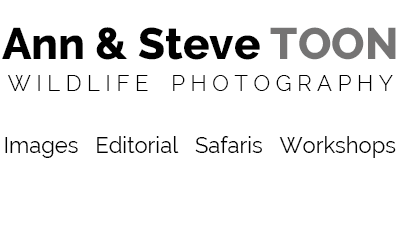We’re always on the lookout for ways to change things when we’re photographing, in an effort to keep our portfolio of images as fresh and varied as possible. Wildlife photography’s a competitive business and with the huge proliferation of great pictures out there it’s increasingly important to keep our eyes, and minds open, to different approaches, where merited, to much-photographed subjects.
One of the simplest ways to breathe a hint of fresh air into wildlife images of commonly snapped species is to photograph subjects within the wider landscape. This means ignoring the advice, and our natural inclination, to ‘go close and then closer still’ when we’ve got a good subject in front of the lens and go minimal instead.

We wanted to big up the dramatic wall of stormy sky at sunset so kept the zebra small
We enjoy the challenge this approach offers, where conditions and circumstances allow, to produce ‘animal miniatures’ where our subjects are often just a tiny fraction of the frame; dwarfed by the surrounding landscape and/or sky.

How small dare you go? We wanted to capture the mood of day’s departure on the Chobe
It’s fascinating seeing how small you can take an imposing, heavy-weight wildlife subject like an elephant and make the picture work. It’s subjective, of course, but, looking through the wrong end of the telescope does seem to help communicate and emphasise the scale, stark beauty and significance of place, time and habitat.

The wonder of the hare’s wilderness winter homeland is captured best by stepping back
You might think this is something that only works in exotic locations, and isn’t really ‘a thing’ for photographing closer to home. Interestingly, we’ve found, this style of shooting wildlife, if you can call it that, can be as successful for mountain hares in the UK’s upland snowscapes, for example, as it can be for imposing, iconic animals, such as elephants and giraffes on the vast plains of Africa.

The endless plains of Africa dwarfing the earth’s biggest land mammals
It’s never a bad idea, anyway, when you’re out in the field, to get some shots of your subject from a distance – just in case the subject won’t tolerate a closer approach. It’s what we try to do. Even if it’s just a ‘grab’ to show each other later what we came across while stalking.
If, like us, you’re generally out and about on foot with a telephoto zoom at hand (we love our trusty Canon 100-400mm zooms for this) you can swiftly assess the potential for a ‘wildlife in the landscape’ shot by reframing the scene in front of you at different focal lengths as you proceed. Once you’ve got your eye in you won’t even need to hold the camera to your eye to make such judgments…
The next step is elevating things to produce a pleasing picture. Here are five general tips we find handy:
1.Study landscape photography as closely as you do wildlife photography, when not in the field, and familiarise yourself with the key elements you need for a successful landscape shot.

Elephants close-up in Kruger is simple – the challenge is showing them well in that vastness
2. Make a beeline for places where good wildlife subjects and great scenery collide; keeping a look-out for strong and simple ‘elemental’ or graphic backdrops that would look brilliant with a wild animal standing proud or walking through them. Generally it’s a good idea to avoid busy scenes with lots going on in them that might risk your subject being overpowered.

Giraffe in miniature crossing the rocky terrain of northern Namibia
3. Pick your moment and be patient. Add the magic ingredient of great light to the locale you’ve identified or some spectacular weather for an extra pop. In an ideal world we’re looking to include either interesting cloud formations, stormy skies, a rainbow, the setting sun or a moon, for example.

The ‘rainy’ season often presents a multitude of photogenic skies for this shooting style
4. Place animal subjects very carefully within the landscape – almost always moving or looking into the frame and generally offset rather than central. As when shooting silhouettes subjects must be well defined, and never obscured, given their diminutive status. The rule of thirds is very useful here. The power points where the thirds intersect are reliable ‘hotspots’ from which your subjects can shine.

Black-maned lion at Kij Kij in the Kgalagadi purposefully patrols his territory
5. Be bolder. Go even more Gulliver and turn large animals into small ants crawling across this vast planet we share…

If you want to capture the essence of an African scene pull back and reveal the full picture
The aim isn’t simply to faithfully reproduce a documentary record of your subject’s habitat remember. You’re looking to produce a response from the your viewer about the bigger picture in the natural world with such shots.
After all, they do say small is beautiful.

Bull elephant with moon – our departing shot!

